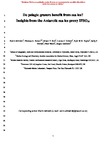Do pelagic grazers benefit from sea ice? Insights from the Antarctic sea ice proxy IPSO25
| dc.contributor.author | Schmidt, Katrin | |
| dc.contributor.author | Brown, TA | |
| dc.contributor.author | Belt, Simon | |
| dc.contributor.author | Ireland, LC | |
| dc.contributor.author | Taylor, KWR | |
| dc.contributor.author | Thorpe, SE | |
| dc.contributor.author | Ward, P | |
| dc.contributor.author | Atkinson, A | |
| dc.date.accessioned | 2018-09-10T08:48:13Z | |
| dc.date.available | 2018-09-10T08:48:13Z | |
| dc.date.issued | 2018-04-04 | |
| dc.identifier.issn | 1726-4170 | |
| dc.identifier.issn | 1726-4189 | |
| dc.identifier.uri | http://hdl.handle.net/10026.1/12269 | |
| dc.description.abstract |
<jats:p>Abstract. Sea ice affects primary production in polar regions in multiple ways. It can dampen water column productivity by reducing light or nutrient supply, provide a habitat for ice algae and condition the marginal ice zone (MIZ) for phytoplankton blooms on its seasonal retreat. The relative importance of three different carbon sources (sea ice derived, sea ice conditioned, non-sea-ice associated) for the polar food web is not well understood, partly due to the lack of methods that enable their unambiguous distinction. Here we analysed two highly branched isoprenoid (HBI) biomarkers to trace sea-ice-derived and sea-ice-conditioned carbon in Antarctic krill (Euphausia superba) and relate their concentrations to the grazers' body reserves, growth and recruitment. During our sampling in January–February 2003, the proxy for sea ice diatoms (a di-unsaturated HBI termed IPSO25, δ13C = −12.5 ± 3.3 ‰) occurred in open waters of the western Scotia Sea, where seasonal ice retreat was slow. In suspended matter from surface waters, IPSO25 was present at a few stations close to the ice edge, but in krill the marker was widespread. Even at stations that had been ice-free for several weeks, IPSO25 was found in krill stomachs, suggesting that they gathered the ice-derived algae from below the upper mixed layer. Peak abundances of the proxy for MIZ diatoms (a tri-unsaturated HBI termed HBI III, δ13C = −42.2 ± 2.4 ‰) occurred in regions of fast sea ice retreat and persistent salinity-driven stratification in the eastern Scotia Sea. Krill sampled in the area defined by the ice edge bloom likewise contained high amounts of HBI III. As indicators for the grazer's performance we used the mass–length ratio, size of digestive gland and growth rate for krill, and recruitment for the biomass-dominant calanoid copepods Calanoides acutus and Calanus propinquus. These indices consistently point to blooms in the MIZ as an important feeding ground for pelagic grazers. Even though ice-conditioned blooms are of much shorter duration than blooms downstream of the permanently sea-ice-free South Georgia, they enabled fast growth and offspring development. Our study shows two rarely considered ways that pelagic grazers may benefit from sea ice: firstly, after their release from sea ice, suspended or sinking ice algae can supplement the grazers' diet if phytoplankton concentrations are low. Secondly, conditioning effects of seasonal sea ice can promote pelagic primary production and therefore food availability in spring and summer. </jats:p> | |
| dc.format.extent | 1987-2006 | |
| dc.language | en | |
| dc.language.iso | en | |
| dc.publisher | European Geosciences Union | |
| dc.title | Do pelagic grazers benefit from sea ice? Insights from the Antarctic sea ice proxy IPSO25 | |
| dc.type | journal-article | |
| dc.type | Journal Article | |
| plymouth.author-url | http://gateway.webofknowledge.com/gateway/Gateway.cgi?GWVersion=2&SrcApp=PARTNER_APP&SrcAuth=LinksAMR&KeyUT=WOS:000429157700003&DestLinkType=FullRecord&DestApp=ALL_WOS&UsrCustomerID=11bb513d99f797142bcfeffcc58ea008 | |
| plymouth.issue | 7 | |
| plymouth.volume | 15 | |
| plymouth.publication-status | Published online | |
| plymouth.journal | Biogeosciences | |
| dc.identifier.doi | 10.5194/bg-15-1987-2018 | |
| plymouth.organisational-group | /Plymouth | |
| plymouth.organisational-group | /Plymouth/Faculty of Science and Engineering | |
| plymouth.organisational-group | /Plymouth/Faculty of Science and Engineering/School of Geography, Earth and Environmental Sciences | |
| plymouth.organisational-group | /Plymouth/REF 2021 Researchers by UoA | |
| plymouth.organisational-group | /Plymouth/REF 2021 Researchers by UoA/UoA07 Earth Systems and Environmental Sciences | |
| plymouth.organisational-group | /Plymouth/Research Groups | |
| plymouth.organisational-group | /Plymouth/Research Groups/Marine Institute | |
| plymouth.organisational-group | /Plymouth/Users by role | |
| plymouth.organisational-group | /Plymouth/Users by role/Academics | |
| plymouth.organisational-group | /Plymouth/Users by role/Researchers in ResearchFish submission | |
| dcterms.dateAccepted | 2018-03-02 | |
| dc.identifier.eissn | 1726-4189 | |
| dc.rights.embargoperiod | Not known | |
| rioxxterms.versionofrecord | 10.5194/bg-15-1987-2018 | |
| rioxxterms.licenseref.uri | http://www.rioxx.net/licenses/all-rights-reserved | |
| rioxxterms.licenseref.startdate | 2018-04-04 | |
| rioxxterms.type | Journal Article/Review | |
| plymouth.funder | Integrating Macroecology and Modelling to Elucidate Regulation of Services from Ecosystems (IMMERSE)::NERC |


